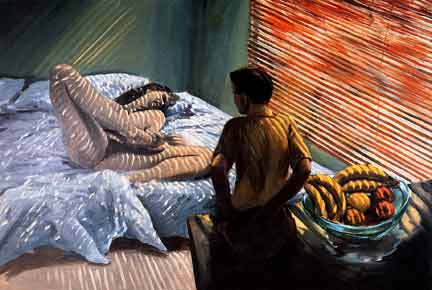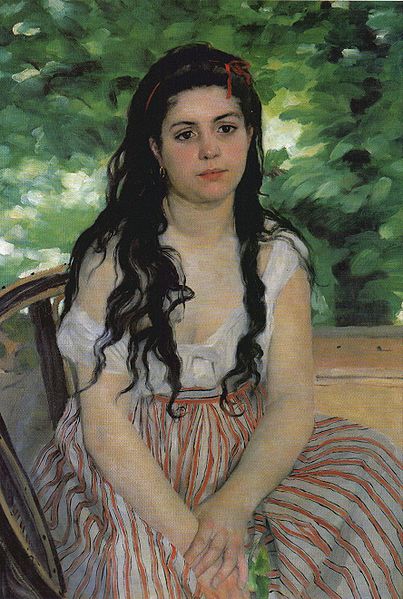On 7 Sep, 2010 With
When this painting first appeared around 1930, it was praised as a work byBotticelli. Not long afterwards, however, the investigations of art historians and scientists revealed it to be an outright fake, made with the intention to deceive. Acquisition The noted art collector Lord Lee of Fareham bought the Madonna of the Veil in 1930 from an Italian dealer for the sum of $25,000. He subsequently bequeathed it to The Courtauld Gallery, London in 1947. Despite a lack of information about its origins, the picture was universally hailed by connoisseurs and academics as a masterpiece by Botticelli when it first arrived in London in the early 1930s. The directors of the Medici Society published the painting as a ‘superb composition of the greatest of…
Read More
On 6 Sep, 2010 With
Photorealism Photorealism is the genre of painting based on using the camera and photographs to gather information and then from this information, creating a painting that appears to be very realistic like a photograph. The term is primarily applied to paintings from the United States art movement that began in the late 1960s and early 1970s. History Origins As a full-fledged art movement, Photorealism evolved from Pop Art and as a counter to Abstract Expressionism as well as Minimalist art movements in the late 1960s and early 1970s in the United States. Photorealists use a photograph or several photographs to gather the information to create their paintings and it can be argued that the use of a camera and photographs is an acceptance of Modernism….
Read More
On 5 Sep, 2010 With
Maximalism Maximalism is a term used in the arts, including literature, visual art, music, and multimedia. It is used to explain a movement or trend by encompassing all factors under a multi-purpose umbrella term like expressionism. The term maximalism is sometimes associated with post-modern novels, such as by David Foster Wallace and Thomas Pynchon, where digression, reference, and elaboration of detail occupy a great fraction of the text. This sort of literature is also frequently described as hysterical realism, a term coined by James Wood, who argues that it is a genre similar to magical realism. Novelist John Barth defines literary maximalism through the medieval Roman Catholic Church’s opposition between, “two…roads to grace:” the via negativa of the monk?s cell and the hermit?s cave, and the via affirmativa of immersion in human…
Read More
On 4 Sep, 2010 With
New European Painting emerged in the 1980s and has clearly reached a critical point of major distinction and influence in the 1990s with painters like Gerhard Richter andBracha Ettinger whose paintings have established and continue to create a new dialogue between the historical archive, American Abstraction and figurality, followed by painters like Luc Tuymans, Marlene Dumas and others. A third wave came with artists like Neo Rauch, Michaël Borremans and Chris Ofili. Bad boy, oil on linen, 66 inches x 96 inches by Eric Fischl Neo-expressionism and other related movements in painting have emerged in the final two decades of the 20th century in Europe and in the United States, but this New Painting is not expressionist. Rather it is a renovative kind of abstraction and…
Read More
On 3 Sep, 2010 With
York Avenue HQ Illegal antiquities In 1997, a Channel 4 Dispatches programme alleged that Sotheby’s had been trading in antiquities with no published provenance, and that the organisation continued to use dealers involved in the smuggling of artifacts. As a result of this exposé, Sotheby’s commissioned their own report into illegal antiquities, and made assurances that only legal items with published providence would be traded in the future. Price fixing scandal In February 2000, A. Alfred Taubman and Diana (Dede) Brooks, the CEO of the company, stepped down amidst a price fixing scandal. The FBI had been investigating auction practices in which it was revealed that collusion involving commission fixing between Christie’s and Sotheby’s was occurring. In October 2000, Brooks…
Read More
On 2 Sep, 2010 With
Superflat is a postmodern art movement, founded by the artist Takashi Murakami, which is influenced by manga and anime. It is also the name of a 2001 art exhibition, curated by Murakami, that toured West Hollywood, Minneapolis and Seattle. Description Superflat is used by Murakami to refer to various flattened forms in Japanese graphic art, animation, pop culture and fine arts, as well as the “shallow emptiness of Japanese consumer culture.” A self-proclaimed art movement, it was a successful piece of niche marketing, a branded art phenomenon designed for Western audiences. In addition to Murakami, artists whose work is considered “Superflat” include Chiho Aoshima, Mahomi Kunikata, Sayuri Michima, Yoshitomo Nara, Tatsuyuki Tanaka, and Aya Takano. In addition, some animators within anime and some mangaka are considered Superflat, especially Koji Morimoto (and much of the output of his…
Read More
On 1 Sep, 2010 With
Bohemianism refers to the practice of an unconventional lifestyle, often in the company of like-minded people, involving musical, artistic or literary pursuits, with few permanent ties. Bohemians can be wanderers, adventurers, or vagabonds. While the term Bohemian actually means origination from the Eastern European and Slavic country of Bohemia, it was later used colloquially by the French and then in the English language in the nineteenth century to describe the non-traditional lifestyles of marginalized and impoverished artists, writers, journalists, musicians, and actors in major European cities. Bohemians, in this colloquial use of the word, were associated with unorthodox or anti-establishment political or social viewpoints, which were often expressed through free love, frugality, and/orvoluntary poverty. Origin of the term The term Bohemianism emerged in France in the early 19th century when artists and creators…
Read More
On 1 Sep, 2010 With
Virtual art (in terms of media art) is art practice using virtual reality, augmented reality or mixed reality as a medium. It can be considered a post-convergent art form, containing all previous media as subsets. Notable artists producing virtual art: Maurice Benayoun Brody Condon Char Davies Michael Naimark Myron Krueger Stefan Roloff Jeffrey Shaw Peter Weibel Source: en.wikipedia.org.com
Read More
On 31 Aug, 2010 With
Superstroke is a term used for an post modern art movement with its origins in South Africa. Superstroke is one of the influential art movements regarding African modernism and abstraction. The word “Superstroke” implies the super expressive brush stroke. The Superstroke art movement was initially founded as a reaction to the impact that the Superflat art movement, founded by Takashi Murakami had on modern contemporary art. Manifesto The manifesto for the Superstroke art movement was written in 2008 by the South African artist Conrad Bo and deals with various forms of how paintings in the movement should be executed. This includes the statement that paintings should be created by using very expressive brush strokes. The manifesto also deals with photography…
Read More
On 30 Aug, 2010 With
Jonas Burgert (born 1969, Berlin, Germany) is an artist based in Berlin. He has shown work in many exhibitions including Rohkunstbau at Stipendiaten in Berlin, Geschichtenerzähler at Hamburg Kunsthalle and Dis-Positiv at Staatsbank in Berlin. Burgert has exhibited internationally at museums and galleries such as Galerie Sfeir-Semler, Beirut and Villa Manin , Passariano, Italy and was part of the Malerei Biennale in Stockholm in 2003. He is represented by Produzentengalerie in Hamburg. Source: en.wikipedia.org
Read More



